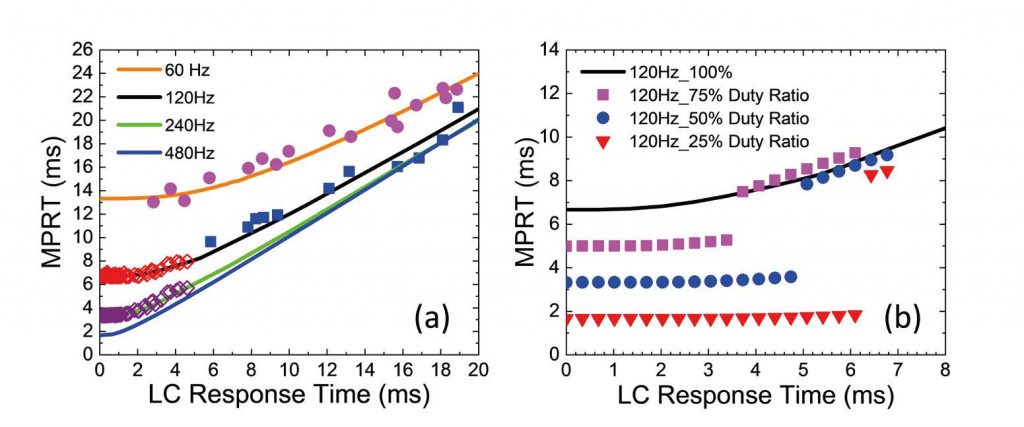Virtual reality (VR) is an emerging wearable display technology with potential applications for entertainment, education, training, design, advertisement, and medical diagnostics. Both liquid crystal display (LCD) and organic light-emitting diode (OLED) are applicable for such head-mounted displays. Currently, OLED is a favored choice because of its fast response time, which helps to suppress image blurs and latency. However, OLED is a current-driven device and it has some shortcomings, such as image burn-in and compromised lifetime for getting high luminance. On the other hand, LCD is a voltage-driven device, and it offers high resolution, high brightness, long lifetime and low cost, but its response time is about 1000 times slower than that of OLED (ms versus s). As a result, LCD is generally perceived to exhibit much more severe image blurs than OLED. This long-lasting “common perception”, however, was recently proven to be incorrect, according to the research led by Prof. Shin-Tson Wu at CREOL. Wu’s group demonstrated that a LCD is capable to achieve comparable or even faster motion picture response time (MPRT) than OLED.
MPRT is a common display metric to quantify the visual performance of a moving object. MPRT is jointly determined by the response time of LC or OLED, the frame rate of thin-film transistor (TFT), and duty ratio. Previously, calculating MPRT was rather difficult because multiple effects are involved, like sample-and-hold effect, motion pursuing, and human vision effect. But this task becomes incredibly simple, as Wu’s group analyzed the origin of MPRT and derived an analytical equation to calculate MPRT. These results have been published in Optica and J. Appl. Phys. recently.

This equation serves as a powerful tool to mitigate LCD/OLED image blurs. At the same time, it unveils several important physical insights: 1) Increasing frame rate is an effective approach to suppress image motion blur, but its improvement gradually saturates. As shown in the figure, from 60 fps to 120 fps the MPRT exhibits a big jump, but as the TFT frame rate continues to increase to 240 fps and 480 fps, the improvement gradually saturates. 2) As the LC response time decreases, MPRT decreases almost linearly, and then saturates. It means MPRT is mainly determined by the TFT frame rate once LC response time is fast enough. 3) When the LC response is less than 2 ms, its MPRT is comparable to that of OLED, even if OLED’s response time is assumed to be 0.
Another effective approach to reduce MPRT without increasing TFT’s frame rate is to decrease the duty ratio. For LCDs, it is the on-time of the backlight in each frame. As duty ratio decreases, the effective MPRT decreases linearly, and the MPRT is insensitive to the LC response time. This is because the backlight is turned on only after the LC molecules have reached their designed gray levels, so that the beginning slow-response part is obscured. Although low duty ratio significantly reduces the MPRT, an obvious tradeoff is reduced brightness. To compensate for the decreased luminance, we could boost the driving current of the LED backlight or OLED panel. However, LED/OLED lifetime and efficiency would be degraded. Fortunately, these negative effects for LED are substantially weaker than the efficiency roll-off and compromised lifetime for OLED. That is to say, OLED is much more vulnerable than LCD to impulse driving.
In summary, Wu’s group has demonstrated an advanced LCD with comparable or even faster MPRT than OLED. This provides a solid foundation for LCD to enter virtual reality space. As a matter of fact, in 2018 Facebook did switch from OLED to LCD in its 2nd Generation VR headset, called Oculus Go. Meanwhile, several high-tech companies are also exploring this possibility. It is expected that more and more LCD based VR devices will be announced in the near future.
